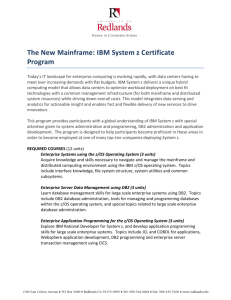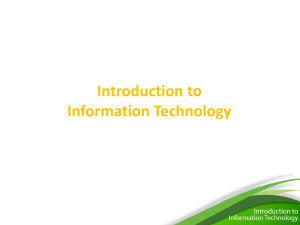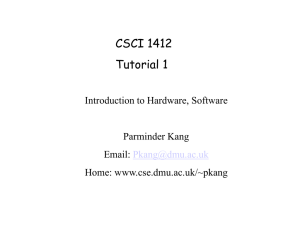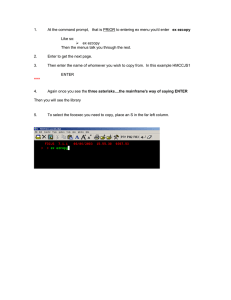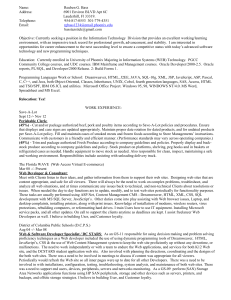Mainframe Modernization and Skills: The Myth and the Reality
advertisement
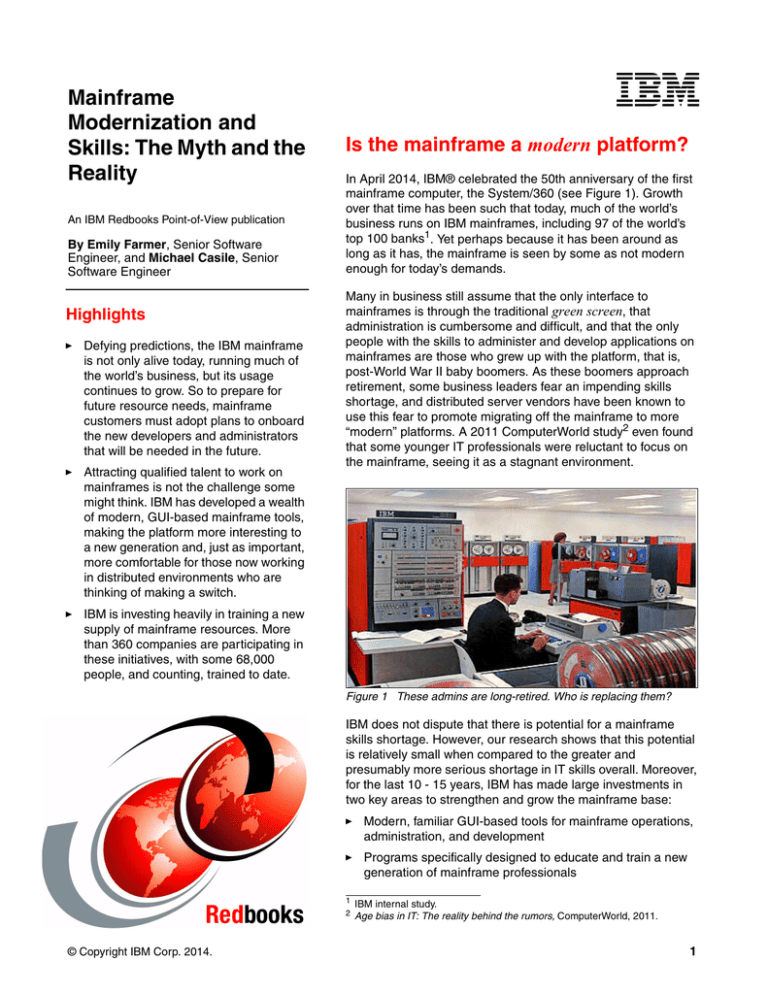
Mainframe Modernization and Skills: The Myth and the Reality An IBM Redbooks Point-of-View publication By Emily Farmer, Senior Software Engineer, and Michael Casile, Senior Software Engineer Highlights Defying predictions, the IBM mainframe is not only alive today, running much of the world’s business, but its usage continues to grow. So to prepare for future resource needs, mainframe customers must adopt plans to onboard the new developers and administrators that will be needed in the future. Attracting qualified talent to work on mainframes is not the challenge some might think. IBM has developed a wealth of modern, GUI-based mainframe tools, making the platform more interesting to a new generation and, just as important, more comfortable for those now working in distributed environments who are thinking of making a switch. Is the mainframe a modern platform? In April 2014, IBM® celebrated the 50th anniversary of the first mainframe computer, the System/360 (see Figure 1). Growth over that time has been such that today, much of the world’s business runs on IBM mainframes, including 97 of the world’s top 100 banks1. Yet perhaps because it has been around as long as it has, the mainframe is seen by some as not modern enough for today’s demands. Many in business still assume that the only interface to mainframes is through the traditional green screen, that administration is cumbersome and difficult, and that the only people with the skills to administer and develop applications on mainframes are those who grew up with the platform, that is, post-World War II baby boomers. As these boomers approach retirement, some business leaders fear an impending skills shortage, and distributed server vendors have been known to use this fear to promote migrating off the mainframe to more “modern” platforms. A 2011 ComputerWorld study2 even found that some younger IT professionals were reluctant to focus on the mainframe, seeing it as a stagnant environment. IBM is investing heavily in training a new supply of mainframe resources. More than 360 companies are participating in these initiatives, with some 68,000 people, and counting, trained to date. Figure 1 These admins are long-retired. Who is replacing them? IBM does not dispute that there is potential for a mainframe skills shortage. However, our research shows that this potential is relatively small when compared to the greater and presumably more serious shortage in IT skills overall. Moreover, for the last 10 - 15 years, IBM has made large investments in two key areas to strengthen and grow the mainframe base: Modern, familiar GUI-based tools for mainframe operations, administration, and development Programs specifically designed to educate and train a new generation of mainframe professionals 1 Redbooks © Copyright IBM Corp. 2014. 2 IBM internal study. Age bias in IT: The reality behind the rumors, ComputerWorld, 2011. 1 In this IBM Redbooks® Point-of-View publication, we look closer at the issues of mainframe modernization and skills requirements. Our goals are to clarify the misperceptions, introduce some of the many modern mainframe tools that are available today, and present a set of guidelines for organizations that lack a solid plan for developing or acquiring future mainframe administration and development skills. (see Figure 2). So, mainframe usage is growing and more mainframe administrators will be needed, but mainframe-dependent customers are not all preparing adequately. Clearly, now is the time to start planning for back-filling and growing your mainframe support staff, whether by hiring new people or by cross-training those already in your organization. 62% of System z customers will need to add mainframe skills in the next 5 years Are you planning for the future? Although the mainframe platform has been declared dead more than once, numerous independent studies show that mainframe usage is actually growing and will continue to grow. A 2012 study by Vanson Bourne, commissioned by Compuware, found that 62% of businesses using mainframes (out of 520 respondents) were expanding their usage from back-end functions to more front-end, public-facing services, including mobile applications.3 Another Vanson Bourne study, from early 2014, states that 89% of mainframe customers planned to keep their mainframes for at least five more years, with more than a third of them intending to keep their mainframes for 10 - 20 or more years4, indicating continued satisfaction with the platform. IBM internal data also shows a continuing increase in mainframe usage. Because overall use of the platform continues to grow, a large crop of new mainframe administrators will be needed over the next several years. Based on current growth patterns, IBM predicts that approximately 37,200 new mainframe administration positions will emerge worldwide by 2020. And because many of today’s mainframe administrators might retire by then, a worst-case scenario holds that approximately 84,000 mainframe administrators will be needed by 2020. Demand for mainframe personnel is not new, given the consistent growth in mainframe use over time. But the timing is critical, especially in the context of upcoming baby-boomer retirements. So what is needed is an actionable resource or talent plan that will ensure the required labor pool is available when needed. Unfortunately, our own internal tracking of IBM System z® mainframe customers indicates that 55% of them do not have a sufficient talent plan in place, even though 62% of customers recognize they will have a skills shortage within the next five years5 3 4 5 2 Mainframe Outsourcing: Removing the Hidden Costs, Compuware Corporation, 2012. The challenges of using mainframes, Micro Focus, 2014. IBM internal study. Additional skills not needed now or in 5 years Skills needed in 3-5 years Skills needed in 1-3 years Additional skills needed now Figure 2 By the numbers: Mainframe skills will be needed An interesting side note is provided by the US Bureau of Labor Statistics, which predicts that approximately 810,000 new and replacement administrators will be needed across all IT platforms by 2020 in the US alone6. Hence, the projected worst-case 84,000-person shortfall in qualified mainframe personnel is only a fraction of the greater problem, and each company’s talent plan must cover all platforms within the data center, not only the mainframe. What’s next: How IBM is helping IBM is addressing the mainframe skills shortage in two ways. For one, the company has put in place a wealth of browser and GUI-based mainframe development and administration tools. This simplifies administration of the platform and helps make it more attractive to a younger generation, and reduces the learning curve when cross-training existing personnel. In addition, IBM has launched several programs that are directly aimed at educating a new generation of mainframe experts. According to our own estimates, the number of new administrators trained through these programs should 6 2013 Occupational Outlook, US Department of Labor, Bureau of Labor Statistics, March 2013. Mainframe Modernization and Skills: The Myth and the Reality be enough to cover the anticipated mainframe skills shortfall through the next six years7. SHARE and other mainframe user-group organizations have developed similar education and training programs that are also yielding positive results. Investing in mainframe tools Historically, System z administration and programming has been notably different from other platforms, often requiring specialized skills. But over the years, IBM has listened to concerns of customers and created new tools (many of them provided at no additional cost) that make these tasks easier. Although the classic green screen still exists, IBM has added many intuitive, GUI-based tools for mainframe administration and application development. Today, green screen knowledge is not needed to be an effective system administrator, or to build, run, and manage mainframe applications. Administrators and developers with existing GUI and Eclipse knowledge can now feel quite comfortable working on a mainframe. includes full administrative capabilities for managing CICS applications running on the mainframe. With it, system administrators can work at a higher level (such as with groups of CICS regions); the details are handled by the underlying capabilities of the tools. Using wizards, the administrator can define new topologies for CICS applications and new CICS bundles for subsequent management and deployment. These features modernize administration of CICS applications; extending the applications for new uses becomes easier. Here are several modern mainframe administration and development tools that are now available and that can ease the expected shortage of mainframe-related skills. IBM z/OS® Management Facility (z/OSMF) is a browser-based application used to manage day-to-day z/OS operations. It is role-based and scenario-based, simplifies tasks, ensures secure access control, and easily integrates with other management tools. This gives z/OSMF a relatively short learning curve, and its GUI features, such as dashboards, wizards, and interactive help, enable new administrators to become productive faster. The tool even includes an emulated green screen interface for administrators who are used to working that way. IBM Explorer for z/OS, also called z/OS Explorer, is an Eclipse-based workbench that interacts with a breadth of additional Eclipse tools (including IBM CICS® Tools, CICS and IBM WebSphere® MQ Explorer, Problem Determination Tools, and IBM Rational® tools). In this way, z/OS Explorer centralizes development, testing, and management of z/OS applications and their supporting infrastructures. And like z/OSMF, z/OS Explorer offers interactive help, wizards, and other forms of automation. IBM CICS Explorer® (see Figure 3) is an Eclipse plug-in that is accessible from z/OS Explorer and 7 IBM internal study. Figure 3 Familiar, GUI-based interface in CICS Explorer IBM Wave is for customers who use Linux and IBM z/VM® on their mainframes, and is a browser-based graphical workspace that simplifies management of z/VM instances and Linux virtual servers. It provides a view across the entire z/VM environment, spanning partitions, servers, sites, and geographies, and enables easy monitoring, provisioning, and management of projects and virtual servers. IBM Wave even includes an intuitive drag-and-drop capability for Live Guest Mobility (moving Linux virtual servers to various z/VM instances). IBM Wave has been shown to significantly improve administrator productivity and reduce mainframe administration costs.7 IBM Rational Developer for System z (Rational Dev/z) is the leading mainframe application development tool from IBM. Rational Dev/z runs in the Eclipse environment, the same rich, integrated GUI platform used by most distributed platform developers. Rational Dev/z fully supports development and reuse of mainframe assets, including all mainframe languages (COBOL, PL/I, C/C++, assembler, Java, and so on) and all mainframe run times (such as CICS, IBM IMS™, Batch, UNIX System Services, IBM DB2®, and 3 WebSphere). Rational Dev/z includes features such as syntax highlighting, error detection, content assist, and interactive remote debugging, which together combine to make development using Rational Dev/z more productive than traditional green screen efforts. For modernizing traditional mainframe applications, Rational Dev/z also includes easy-to-use wrappers for SOAP Web Services and JSON-based mobile interfaces. An important note is that although COBOL has existed for decades, it continues to be used today. A recent ComputerWorld survey asked mainframe users if their organizations are still using COBOL, and 53% responded “yes.” When asked how much it is used, 48% said COBOL is used “a lot,” which was a higher percentage than was reported for Java and several other languages.8 In addition, because COBOL is a straightforward procedural language, developers who are familiar with Java can learn COBOL fairly easily, and using a shared interface such as Rational Dev/z simplifies mainframe development when using both Java and COBOL. Rational Development and Test runs a complete z/OS stack on an x86 Linux server, allowing mainframe developers to rapidly compile, unit test, and prototype their applications while reducing mainframe usage costs and dependencies on operations staff. Rational Development and Test, like Rational Dev/z and other Rational tools, is designed to break down the barriers between those working on distributed and mainframe systems, providing common usage methods and interfaces for all. Investing in the next generation In 2003, IBM launched the Academic Initiative for System z. With mainframe administrators and developers potentially aging out of the workforce, the Academic Initiative aims to provide concerted training in mainframe skills to a younger generation. The Academic Initiative (see Figure 4) works with college and university professors to set up courses that teach mainframe skills. Each program is unique, and IBM and the schools work closely with local IBM clients and Business Partners to create courses that meet their needs. IBM provides much of the course material, plus faculty support and training and remote access to mainframes. 8 4 Figure 4 IBM Academic Initiative website IBM has invested more than $10 million in the Academic Initiative and the program today includes over 1,000 colleges and universities in 67 countries. More than 68,000 students have completed the program, and over 360 companies are engaged and actively recruiting graduates. IBM and the Academic Initiative also sponsor the System z Job Board. For organizations looking to hire talented System z professionals, the System z Job Board is the place to go to find enterprise-level talent. For the past several years, IBM and the Academic Initiative have sponsored a contest called Master the Mainframe. This contest is a three-part challenge for high school and college students, with mastery achieved at each level (so there are multiple winners each year). Each part is increasingly difficult, and together they introduce students to everything from basic mainframe technology to complex COBOL, REXX, and JCL programming. The goal is to provide students with mainframe work experience and to draw them toward a career in the field. In 2014, coincident with celebrations of the mainframe's 50th anniversary, IBM hosted a Master the Mainframe World Championship. Out of 20,000 student contestants from 6 continents, 43 all-stars competed in New York City for the coveted World Champion title. And, all of the students gained exposure to organizations looking for enterprise computing talent. Cobol brain drain: Survey results, ComputerWorld, March 2012 Mainframe Modernization and Skills: The Myth and the Reality Conclusion Resources for more information Mainframe usage data indicates that administrators and developers will be in short supply in the coming years. But using this as justification to abandon the platform is not valid. Mainframes are the only platform that exhibit real economies of scale, as adding new workloads drives down administrative costs per unit of work. More important, the overall IT skills shortage foreseen in the next several years is profound and significant, and must be addressed. No platform will be immune to this shortage. For more information about the IBM Academic Initiative, visit the program website: http://www.ibm.com/university/systemz Additional details about developing mainframe skills for your organization, and ways in which IBM is making the mainframe more attractive as a career, are available at these locations: System z Job Board: http://www.systemzjobs.com Likewise, suggesting that the mainframe lacks modern tools and interfaces is naive. Today, everything from bare-bones z/OS and CICS applications to Linux virtual servers running on z/VM can be managed from a GUI interface. Eclipse tools are available for all aspects of mainframe development and testing, whether it is with legacy COBOL applications or today’s newest Java, web services, and mobile applications. Investments in these tools will significantly improve productivity, breed cross-fertilization of IT skills across departments, and ultimately reduce overall IT expenses through reduced labor costs. Mainframe 50th anniversary website: http://www.ibm.com/mainframe50/ IBM mainframe platform and administration tools: http://www-03.ibm.com/systems/z/os/zos/ IBM mainframe development tools: http://www-03.ibm.com/software/products/en/su bcategory/SWF20 http://www-03.ibm.com/software/products/en/de veloperforsystemz It is critical that businesses closely examine their true IT resource requirements and put plans in place to ensure the right skills are available for the coming decades. Based on the numbers we see, enterprise organizations should plan to onboard, on average, four to seven new mainframe administrators every year. We strongly urge mainframe clients to find local colleges and universities that are participating in the Academic Initiative for System z. Seek out professors who are in the program and work with them to develop a curriculum to meet your upcoming IT needs. Or contact IBM to set up a program specifically for your company. IBM intends to continue working aggressively to ensure that trained mainframe talent is available to companies that need it. 5 Notices This information was developed for products and services offered in the U.S.A. IBM may not offer the products, services, or features discussed in this document in other countries. Consult your local IBM representative for information on the products and services currently available in your area. Any reference to an IBM product, program, or service is not intended to state or imply that only that IBM product, program, or service may be used. Any functionally equivalent product, program, or service that does not infringe any IBM intellectual property right may be used instead. However, it is the user's responsibility to evaluate and verify the operation of any non-IBM product, program, or service. IBM may have patents or pending patent applications covering subject matter described in this document. The furnishing of this document does not give you any license to these patents. You can send license inquiries, in writing, to: IBM Director of Licensing, IBM Corporation, North Castle Drive, Armonk, NY 10504-1785 U.S.A. The following paragraph does not apply to the United Kingdom or any other country where such provisions are inconsistent with local law: INTERNATIONAL BUSINESS MACHINES CORPORATION PROVIDES THIS PUBLICATION "AS IS" WITHOUT WARRANTY OF ANY KIND, EITHER EXPRESS OR IMPLIED, INCLUDING, BUT NOT LIMITED TO, THE IMPLIED WARRANTIES OF NON-INFRINGEMENT, MERCHANTABILITY OR FITNESS FOR A PARTICULAR PURPOSE. Some states do not allow disclaimer of express or implied warranties in certain transactions, therefore, this statement may not apply to you. This information could include technical inaccuracies or typographical errors. Changes are periodically made to the information herein; these changes will be incorporated in new editions of the publication. IBM may make improvements and/or changes in the product(s) and/or the program(s) described in this publication at any time without notice. Any references in this information to non-IBM Web sites are provided for convenience only and do not in any manner serve as an endorsement of those Web sites. The materials at those Web sites are not part of the materials for this IBM product and use of those Web sites is at your own risk. IBM may use or distribute any of the information you supply in any way it believes appropriate without incurring any obligation to you. ® Trademarks IBM, the IBM logo, and ibm.com are trademarks or registered trademarks of International ® Business Machines Corporation in the United States, other countries, or both. These and other IBM trademarked terms are marked on their first occurrence in this information with the appropriate symbol ( or ), indicating US registered or common law trademarks owned by IBM at the time this information was published. Such trademarks may also be registered or common law trademarks in other countries. A current list of IBM trademarks is available on the Web at http://www.ibm.com/legal/copytrade.shtml Redbooks The following terms are trademarks of the International Business Machines Corporation in the United States, other countries, or both: CICS® CICS Explorer® DB2® IBM® IMS™ Rational® Redbooks® Redbooks (logo) System z® WebSphere® z/OS® z/VM® The following terms are trademarks of other companies: Linux is a trademark of Linus Torvalds in the United States, other countries, or both. Java, and all Java-based trademarks and logos are trademarks or registered trademarks of Oracle and/or its affiliates. Other company, product, or service names may be trademarks or service marks of others. Information concerning non-IBM products was obtained from the suppliers of those products, their published announcements or other publicly available sources. IBM has not tested those products and cannot confirm the accuracy of performance, compatibility or any other claims related to non-IBM products. Questions on the capabilities of non-IBM products should be addressed to the suppliers of those products. This information contains examples of data and reports used in daily business operations. To illustrate them as completely as possible, the examples include the names of individuals, companies, brands, and products. All of these names are fictitious and any similarity to the names and addresses used by an actual business enterprise is entirely coincidental. Any performance data contained herein was determined in a controlled environment. Therefore, the results obtained in other operating environments may vary significantly. Some measurements may have been made on development-level systems and there is no guarantee that these measurements will be the same on generally available systems. Furthermore, some measurements may have been estimated through extrapolation. Actual results may vary. Users of this document should verify the applicable data for their specific environment. COPYRIGHT LICENSE: This information contains sample application programs in source language, which illustrate programming techniques on various operating platforms. You may copy, modify, and distribute these sample programs in any form without payment to IBM, for the purposes of developing, using, marketing or distributing application programs conforming to the application programming interface for the operating platform for which the sample programs are written. These examples have not been thoroughly tested under all conditions. IBM, therefore, cannot guarantee or imply reliability, serviceability, or function of these programs. This document, REDP-5115-00, was created or updated on May 30, 2014. © Copyright IBM Corp. 2014. 6
